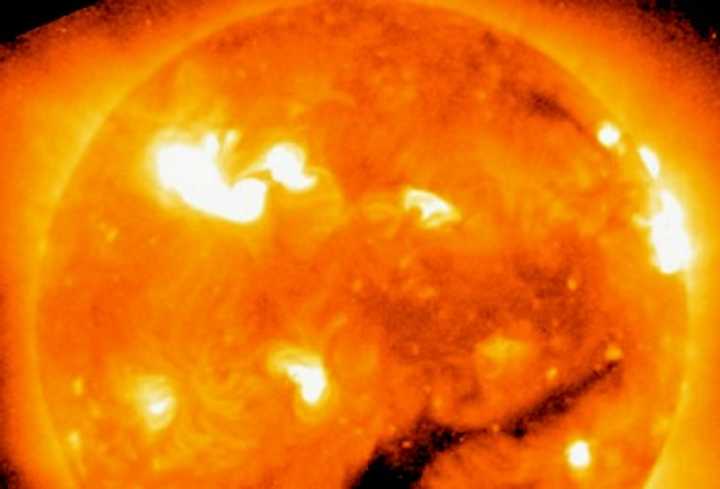UPDATE: So much for the “global Katrina.” Seems we’ve been solar punk’d: The worst of the current solar disturbance wasn’t even felt here on Earth. READ MORE….
The BPU, “in partnership with the independent contractor PJM, [is] prepared to mitigate the effects of these types of events by lowering the grid power output,“ a statewide memo issued early Wednesday evening said. “In extreme cases, the administrators would conduct a ‘shed load’, which are commonly known as ‘rolling blackouts.’ ,“ said the 5:47 p.m. transmittal, a copy of which was obtained by CLIFFVIEW PILOT.
(PJM Interconnection operates the nation’s largest regional power grid, serving more than 50 million people. Many consider it the best-managed regional transmission organization in the country.)
The
“coronal mass ejection“ – the largest in five years – struck Earth’s magnetic field around 6:05 thir morning, cutting some radio communications at the poles and diverted flights that ordinarily crossed the poles. But it didn’t upset electronics and communications anywhere else. All GPS devices remained fixed, for one thing.“All told, it’s not a terribly strong event,” said physicist Joe Kunches of the National Oceanic and Atmospheric Administration (NOAA) at a news conference Thursday.
And although it’s expected to continue into tomorrow, it was nowhere near the “global Katrina” that scientists have said the sun may someday hurl our way.
Instead, Earth got a “glancing blow” that was absorbed by its magnetic field, experts said. It topped out at a level of G3 — as in: strong but not severe or extreme conditions but quickly decelerated to G1. In other words: a non-event.
Not to be confused with solar flares, CMEs are billions of tons of charged particles released from the sun’s outer atmosphere (
or corona) that travel close to the speed of light.They take 20 to 30 hours to reach our atmosphere, with the potential to trigger a geomagnetic storm that can mess with airline flights, GPS systems and radio transmissions.
They can also overcharge a power grid, which is where the concerns lay when the BPU dispatched its Wednesday evening alert.
“[T]he particles can disturb the earth’s magnetic field and produce extra electrical currents,” according to a fact sheet issued by PJM on Jan. 19. “These currents can flow through grid equipment – transformers and power lines – and cause damage, disrupting system operations and reliability.
“To help anticipate problems, PJM and its members have installed special sunburst monitors to measure the extra electrical currents that are caused by SMD,” the Pennsylvania-based agency wrote.“When a solar disturbance is identified, PJM operates the system by reducing the amount of power moving across transmission lines in case the unexpected additional power from the solar disturbance flows on the system,” the sheet says. “Power levels also may be reduced at specific generating stations to protect equipment.”
One of the largest storms in recorded history occurred in 1859, when a coronal mass ejection combined with a large solar flare in what became known as the Carrington Event. Telegraphs went down and sparks flew from communication systems, according to reports from the time.
A weaker storm left 6 million people in and around Quebec without power for nine hours in March 1989. It also melted sections of transformers here in New Jersey, with a force that rendered rolling blackouts useless.
Scientific experts late last year warned that the wrong solar mix could create a “global Katrina,“ citing an increase in solar activity expected to peak next year. Given our reliance on satellite technology, the effects could be severe, they said during a meeting of the American Association for the Advancement of Science.
Three years earlier, scientists at NASA said the Earth’s power grid appears more susceptible than ever to ejections and flares. Although not wanting to be alarmist, they warned that large transformers could blow, knocking out power to more than 100 million people in North America. There would also be a risk of potentially dangerous surges when the juice is restored.
Worst-case scenario: The National Research Council has estimated that a widespread blackout caused by a severe solar magnetic disturbance could cause up to $2 trillion in damages, from which it could take years to recover.
On the positive side, the scientists said the system can withstand a lot. They weren’t expecting an “extreme“ hit but, rather, one that could disrupt all sorts of electrical transmissions. As of 2:30 a.m., that scenario was the likeliest, online experts reported.
{loadposition log}
Click here to follow Daily Voice Fair Lawn-Glen Rock and receive free news updates.

